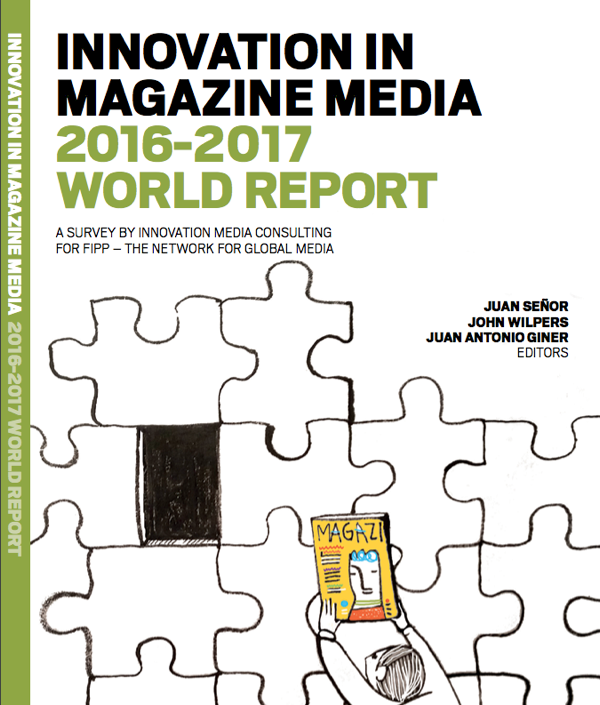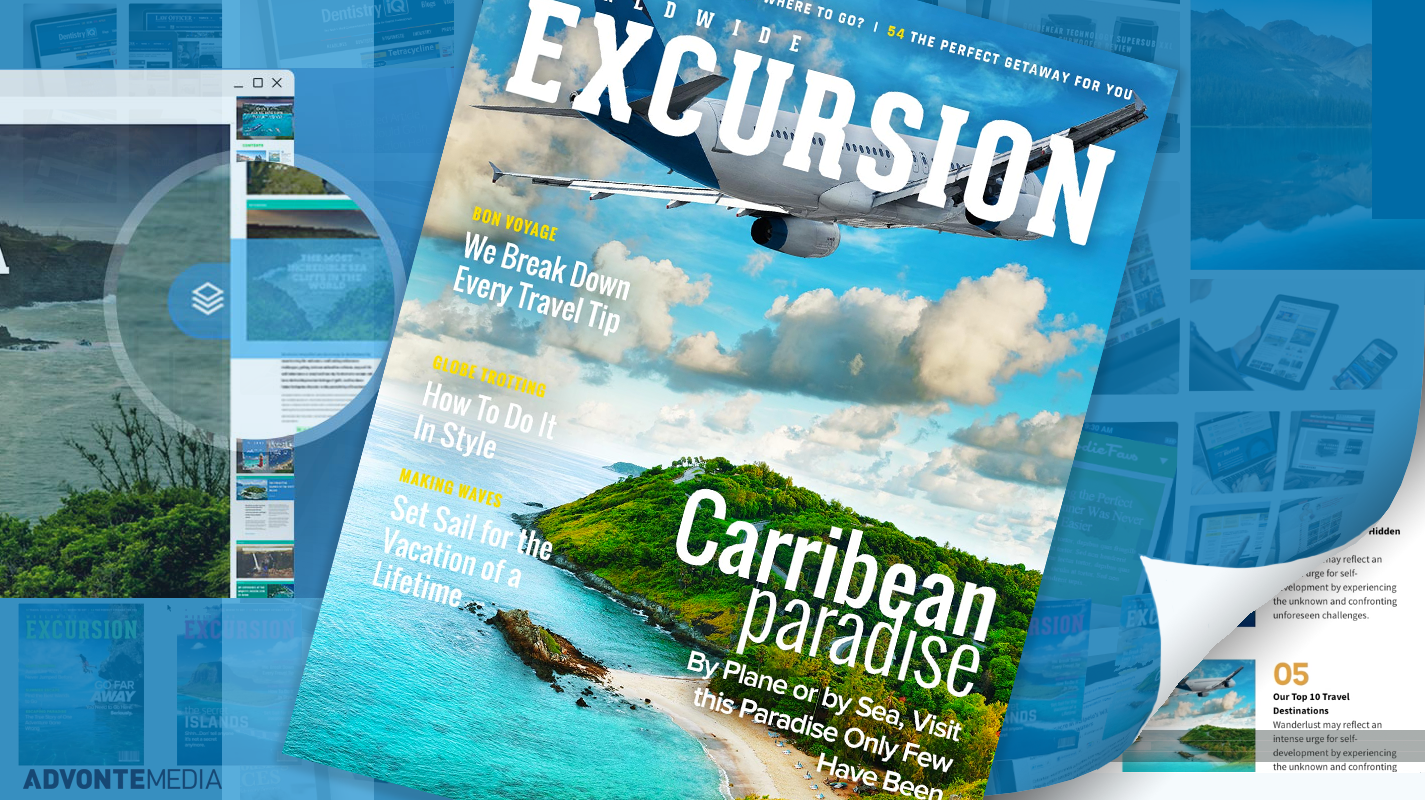
Digital Magazine Edition Publishing Software and Platform Solutions
Digital Magazine Publishing Definition
Digital publishing today can be defined as Publishing content in a digitally accessible format.
Traditional definitions related to publishing in electronic formats placed emphasis on the mediums in which early media formats included disk and cd. These media storages are no longer relevant distribution methods for immediate media accessibility required based on modern audience expectations. We use the terms in our definition based on the following term meanings in the context of magazine publishing:
Term Breakdown for Digital Publishing Definition
- publishing: dissemination and presentation of organized content to audience
- content: edited and/or organized materials presented to communicate value; typically news, knowledge, art or entertainment
- digitally accessible: digital data accessed via mobile or network technology
- format: formatted properly when the published content is presented in an appropriate media channel for the intended audience and is observant of UX principals which facilitate predominately utilized desktop/laptop and mobile/tablet hardware devices of the era
Announcing VERTIQUL by Advontemedia

However, “digital publishing” is a transitional term similar to “digital magazines.” As the vast majority of all published content will be digitally accessed by 2025 we will see the core term “publishing” return as standard to represent both the process and state of published materials without the need for the qualifier “digital.” Instead, we will have to specify “Print edition” to describe the brand extension publishing channel where the ink on paper magazine printing and physical distribution of mailing are used by the publishing company. The term ‘Digital Publishing’ has broadly represented both the process of publishing to digital mediums and the publishing design, content distribution, and content management software or platform utilized within digital publishing processes.
The bridge to our modern understanding of digital publishing has evolved from the origins of digital where the traditional meaning emphasized the process of publishing digital data (1’s and 0’s) to electronic media. Publishers still use software in terms of specific applications that perform a production or presentation component of the publishing business model but the medium is now the Internet. And the trend for the publishing industry is on-demand, cloud based professional publishing services which integrate into the specific publisher business model and deliver greater value to the all-important audience. Publishing suites and cloud platforms aggregate necessary content organization and design tools and vertically integrate steps involved in the publishing workflow to distribution output deliverables. The publishing solution might also include e-commerce or other marketing capabilities to control circulation and access to subscribers.
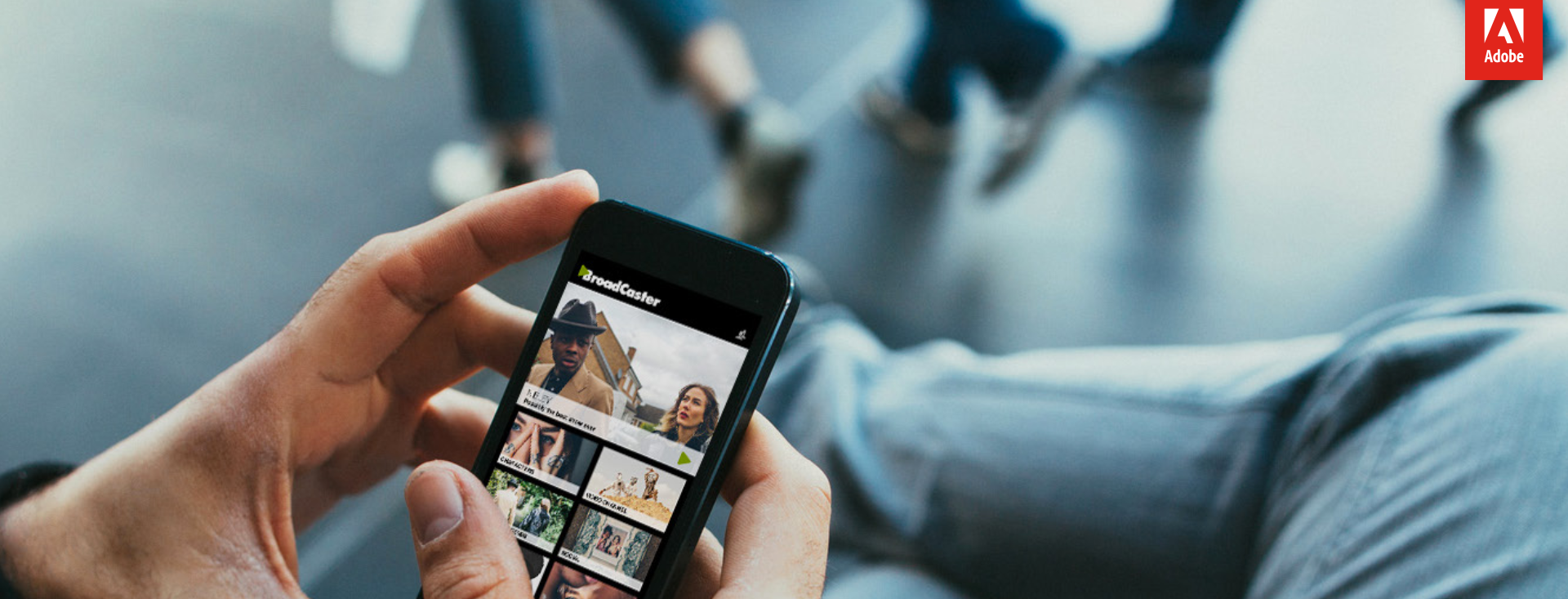
For the magazine design aspects, publishers today still use server/desktop publishing applications such as InDesign (part of the broader Adobe (TM) publishing suite) to design their magazines. Larger publishing companies use enterprise production processes and typically stick with the entire publishing suite toolset. Even as a cloud based publishing suite, the design software is often downloaded based on a software license to the local client workstation.
However, these tools aren’t always a fit for the startup, niche, mid-size and trade publishers that have customized their process to utilize 3rd party vendors, existing publishing software or open-source platform tools. Changes in the pricing or licensing structure of the traditional digital publishing suite option has also prompted publishers to look at alternatives to enterprise marketing suite software packages. Especially when publishers aren’t completely engaged with an all-in process that assumes standardizing design of the magazine for print, web, mobile, app, and digital platforms. Every magazine publishing business model has unique characteristics and many publishers utilize unique components even when there’s not a direct API or integration handoff.
Electronic Publishing Evolution for Magazines
Unique digital edition software, services, and apps allow publishers to choose a method that they feel is best suited to their digital audience. Our focus on reviews of digital magazine publishing options and alternatives is centered on the definition relative to the delivery format and medium – the last mile to the user. Once referred to as electronic publishing, the term epublishing and digital publishing represent more than just periodicals such as magazines and journals. These “e” prefaced terms are dated in our opinion and we wish to differentiate between ebooks / epubs associated with digital books. Reflowable xml content structure for book reading devices and the digital transition to digital reading devices is also defined as digital publishing. However, the requirements and specifications for e-books are different from the dynamic audience engagement of content from periodical publishers and this high-level guide to general category of options for magazine publishers.
This foundational article and definition is a guide for new publishers to gain a basic understanding of modern digital publishing with emphasis on “the digital presentation medium” although solution options are expanding to include facilitation of “the process” of digital publishing.
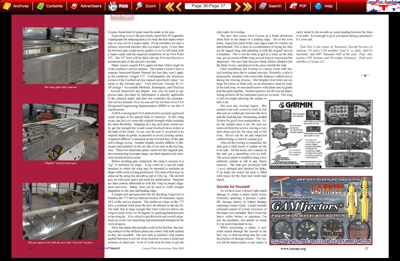
Utilization of the term “Edition” simply denotes that the publication is represented by a multi-channel publishing process, most often a printed publication. In the early days of Internet publishing (late 1990’s and early 2000’s) , magazine publishers utilized digital edition software or web scripts to produce magazine digital editions. This early era of e-publishing was pretty interesting since we didn’t consider the concept of responsive html page code, mobile-friendly breakpoints, and unlimited viewport sized devices. The Internet e-magazine was a desktop computer viewed web page and Flash-based software flipping page scripts were used to simulate the page-turn and shadow effects on the magazine view on a desktop monitor. Next, we saw multimedia files added to the online editions and this was even before streaming media services, so the web server hosting the digital magazine had to handle the video file stream bandwidth. Remember the many video streaming platforms speeding to market for publishers based on the immediate forecast web tv would be the future of content. It took us a little longer to reach the current level of video immersion content mix and edited video has it’s place as a digital content enhancement but it’s not a replacement for the editorial design structure of edited content and visuals. Mix those multimedia elements with the audio effect of a loud crisp page flipping sound and it actually looked like we put a magazine on the screen. The digital edition software scripts and Saas (cloud-based software as a service) digital edition platform tools had to include these features so readers knew this was the online edition. And then came all the social sharing buttons and features like text based translation capabilities in the readability version of the articles. All these features were packed into a tiny toolbar that required onboarding tooltips just to show someone how to flip and page corner on a magazine that had been simulated on a screen.
Digital Edition Software & Magazine Flip Page Scripts
Flip page software and jquery scripts for creating digital editions which mimic the page flipping experience of print have been available for many years. Originally these flash based flipping tools converted print layout magazine PDFs and some interesting how-to guides can be found for media queries in javascript, conditional CSS and responsive jquery for HTML5. PDF conversion, html5 design file exporters, responsive code generators and plugins for Indesign to export HTML are tools used by web developers. Some flipbook plugins have even been created to work with web publishing CMS solutions such as WordPress and Joomla. As responsive web design has become a standard for web content, the latest jquery flipping book software has improved upon original flip-page development code set to mimic the original desktop page peel effect. A two-page slide presentation has also been used to improve on the magazine presentation for desktop/laptop and tablets or phone devices considering multi-device compatibility.
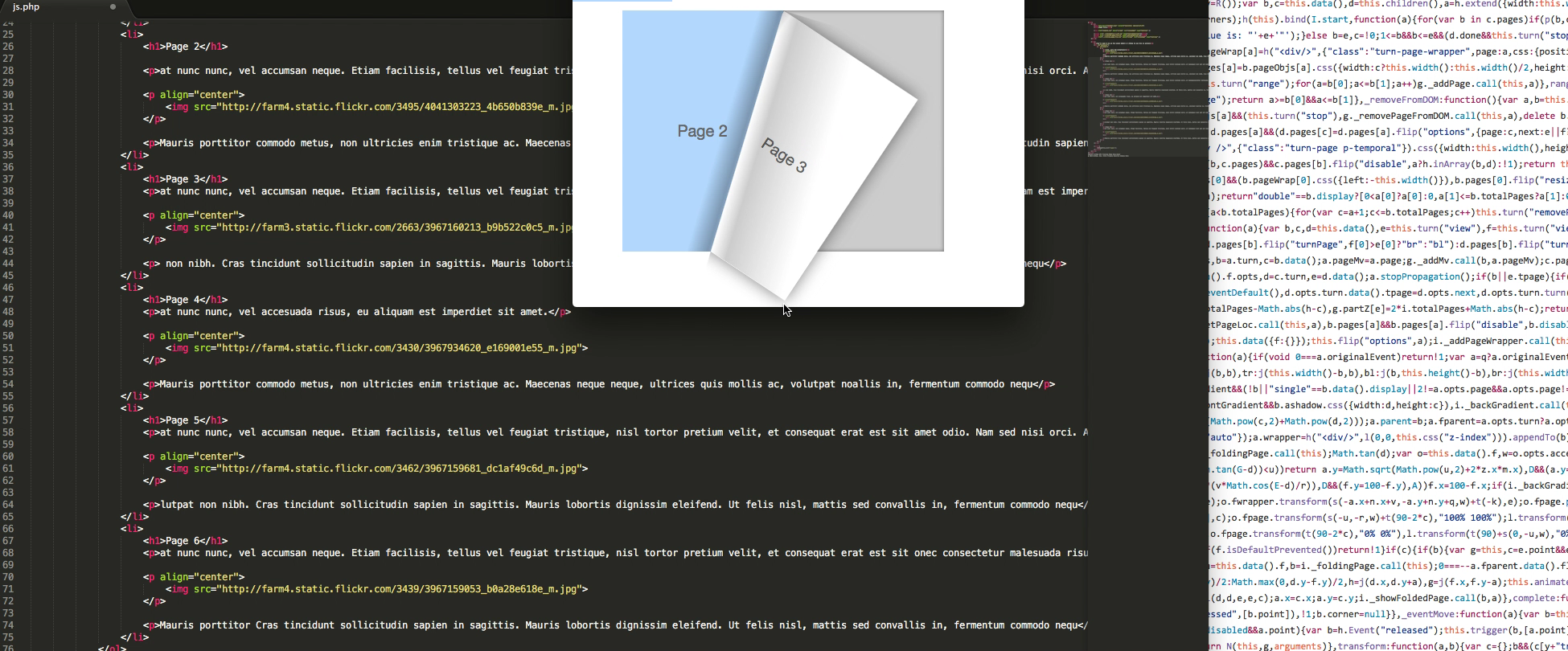
Many of us have experienced the desire to build our own in-house solution to maintain full control. But the core digital flip enablement tools still need to be hosted or staged with a designed skin or player framework. The infrastructure around the core digital edition player is as important as the page turn technology itself. Our own publishing team and web developers sought white-label branding because we didn’t want subscribers arriving at a digital edition where a giant 3rd party powered by logo confused the reader. We had to overlook the platform branding or pay the white label / custom domain branding fee to keep the interface clean. Despite the interest in making the digital publishing solution custom to your magazine it’s good to consider maintenance and upgrades to the digital issue storefront container. Internet standards and devices people will use to interact with the digital editions access site are constantly changing and there’s value in having a hosted platform.
Cloud Based / Hosted Digital Publishing Solutions
Digital edition platform and desktop software conversion can also be performed on a print 2-page up / custom page size layout that was designed with less than print quality assets. The challenge in using the 2-page digital flip or panel slide magazine pdf conversion is the viewport is smaller for typical phones. A magazine set to display on a smartphone (even with increasing resolutions capabilities) is essentially a thumbnail magazine page which requires pinch and zoom.
To provide an example of clicking through higher page count flip edition magazines, consider how some aggressive web publishers seeking higher page views and more advertising impressions stage content in multi-page articles. The articles contain titles like, “10 Amazing and Creative Magazine Covers,” and either web gallery software or individual images are placed on pages with rotator or next page advancement. They know it’s a win to get a visitors to click through a top 10 list. Sometimes they will go for 20 pages and even insert ads between pages. This highly visual content can’t keep a user clicking and waiting for pages to advance much past a dozen items if lucky. An experience where the content is not deliberately designed is a story or sequence, advanced at the user controlled speed and that does not provide progression awareness will not retain the reader.
Another approach is digital first, where the magazine is designed based on a workflow for print layout, but the intention is distinctly digital magazine.
As the current publishing suite is expanded into a larger marketing solutions focus, it’s likely publishers will seek other digital magazine publishing alternatives.
Cloud based magazine publishing platforms that can deliver a complete publisher editions newsstand archive today, will begin to expand their solutions to offer:
- Responsive compatibility for reader presentation on mobile devices
- Design layout tools for multi-viewport, media-queries, cross-channel and responsive designs for desktop, tablet, and smartphone devices
- Remove the business model requirement to create a magazine app and allow just HTML5 digital magazines
Complimentary Circulation Management Software – Digital Compatibility
As publishers seek gated content and conversion and alternatives for better audience circulation management with audience data (3rd-Party Cookies are Ending) the integration with established publication circ tools is often a topic for our consultants. Vendors often included in these calls like a Maghub, Magazine Manager, Omeda, Onecount, Simplecirc, CWC Quickfill and other tools that support digital subscriptions has been spotlighted. Simplicity is key for the audience experience. When you send subscribers a link to their digital edition, the URL should carry the proper information to easily grant access based on the users cookie acceptance for cookies related functional elements. This can also be dynamically added to the subscriber portal regardless of the vendor so providers such as Mozaic, zMags, FlippingPages, VERTIQUL, Issuu or another platform keep issue and archives easily readable if the user chooses the subscriber portal to access. The goal is to avoid another site the subscriber must use to login for content. Passwordl-ess login might be an option to help users when stuck in front of a paywall. It’s understandable that many publishers are fear-full access to non-paid content, but this should not corner them into dual login options or clunky non-branded domains that don’t support usability friendly approaches. We can’t overlook the value of even a simple opt-in for preview access to content where we get the visit to the content with just an email address. The circulation management process used to run magazines and their new subs process can be done after successfully capturing email and then proper audience segment marketing to gain a qualified circulation or paid subscriber upgrade. This is equally true for membership associations and B2B who can have their marketing professionals perform data analysis from the wealth of first-person analytic intelligence. When subscription management platform play nicely with a variety of digital solution, the publisher has the ability to customize and improve on their own hosted editions and not have a limited selection of digital publications or the printer provided flip edition.
The Digital Edition Platform Competitive Covers Pitfall
Some magazine reader apps have started with the forward intention of providing access to an array of magazines. And for these popular newsstand title publishers, the cafeteria ‘all-you-can-eat’ magazine app brings eyeballs to the magazine. This means potential new readership even if the participation is not the default or preferred digital delivery channel. If the costs of app development is profitable and it’s incremental audience growth then it’s just a matter of ‘cover competition’ and brand awareness since the reader gets unlimited digital magazine subscriptions.
But for publishers that place their magazine in a crowded marketplace as the entry point for magazine access we see a downside. Things get more complicated when digital edition platforms switch focus away for what makes sense for the publisher (publisher-to-audience) to foster their own (platform-to-audience) platform brand to the consumer. In some digital magazine platform pricing models, the publisher can pay a premium to get out of the aggregated storefront model where they are mixed in with all the other platform publications. Publishing solutions that originally focused on the needs and business model of the publisher soon realized they could become virtual magazine portals seeking consumer traffic. For top magazines expected on the newsstand, the cafeteria ‘all-you-can-eat’ monthly subscription to all publishers on the platform brings eyeballs to the magazines if the costs of app development are profitable. These publishers must be able to compete in cover and brand awareness in this unlimited digital magazine subscription service the same way they compete on the print newsstand. For many B2B magazines, the publisher doesn’t want competition for audience attention when they refer subscriber to a platform app to read the latest issue. The magazine is the prized periodic deliverable for trade publications. When these publishers send out the email notification to their email list subscribers announcing the new issue, they certainly don’t want dozens of other covers tempting the reader’s interest to move away from their own magazine.

Even if you embed your digital editions, many digital edition PDF conversion platform vendors display a ‘powered by’ bug or solution branding to enticing the publisher’s web edition visitors to click to this directory of other magazine platform publications. Mentioned previously, a typical premium plan feature allows the publisher to turn off the hyperlink and displayed a logo on the magazine issue interface of the publishing technology platform. Most magazine publishers who carefully built their digital publishing strategy don’t want those types of interface branding surprises. They may have started a monthly service plan after viewing an uncluttered interface in a publishing platform demo not realizing that’s an upgrade feature. It’s important to ask questions about how the digital publishing platform makes their money if the price for the digital magazine creation software or conversion is a very small fee based on do-it-yourself production.
Multi-channnel App Publishing Software and Platforms
Digital publishing technology experts and solutions providers that already derived revenue from the publishing services industry in the mid 2000’s entered the magazine app development space when it was clear desktop flip editions were not the holy grail of online magazine reading. Apple iTunes App Store and the Google Play Store meant that publishers could use the base publication newsstand shelf as a medium to give readers a better and more interactive experience. Reading a magazine on a tablet almost felt like the print experience. But there was fragmentation and platform politics in play so some digital edition platforms decided they would offer their own newsstands to avoid sharing revenue with Apple. Zinio was the first large digital player in the space and probably kept busy with the top shelf magazine titles and publishing groups because they weren’t a fit for the indie publisher to start. As dozens of digital publishing app production and content distribution solutions came to market, the justification was clear:
- You’ve got to make your content available to readers where and how they consume content.
- Engagement using simple native publication platform UX features was exciting (more of a neat feel than clutter)
- Print is going away and magazine apps are the future for your readership.
Native magazine apps made perfect sense and seemed like the certain future for magazines formatted specifically to the reader device. Magazine app developers addressed both distribution and adaptation for each platform in providing cross-media design process views. Adobe’s digital publishing software tools allow a publisher to engage in a cross-channel production creating mobile-friendly magazine apps, web content, and print layout / PDF versions. This and other web-based flip page software platforms have been the most popular approach for the past 10 years in magazine digital publishing. Since a majority of our audiences will be on mobile smartphone devices, we must look beyond the tablet and desktop/laptop designed editions. Mobile smartphone magazine apps don’t present the experience we get on a tablet device and it’s hard to justify that much effort for something that could have been done more easily on a responsive web edition.
By 2021, nearly 90% of all internet traffic will be from smartphones
Magazine apps really did present a decent user experience if you subtract the hurdles to actually getting the cover open on the iPad or Android tablet. If you were properly directed to the app store download link you could install the issue management newsstand app and download to the device to the latest issue. Because the magazine newsstand app is only the container for facilitating multiple issues, the user would still need to find and download the specific issue. Add subscription management or paid circulation and authentication to the fragile user experience continuum and we found many people would not rate this as a simple process. In our vertical editions approach discussed below we favored a native web responsive magazine content presentation allowing the issue to exist in the device mobile browser independent of device. We feel that apps are best suited for brand extension utility and not core issue content delivery functions of the magazine brand.
Today there are still many publishing app solutions that provide a workflow for both Apple and Google app stores. These tools offer workflow to design and some are even getting into html5 flow for vertical edition presentation. I forecast that the top magazine app design platforms will transition to web-based vertical content flow design and function as cloud service content management and distribution platforms. An always present challenge for digital magazine apps is the need for art direction and talented graphic design professionals to define the creative structure and presentation of content. As mobile magazine apps reach maturity with design templates and interface design toolsets it’s understandable that their solution model changes to favor other users. Do-it-yourself PDF transition or digital only publication build app capability means that marketers can also use these tools for specialty publications, marketing brochures, reports and other presentations greatly expanding the market for a monthly recurring pricing model. And once a large number of publications exist on the app vendor system, the idea of creating a library portal means more potential traffic with incremental platform advertising.
The Fragmentation of the Entire Magazine Issue
As apps have not resulted in the best publisher-centric model another challenge will soon make the participation in an app based offering just one more generic channel for potential content marketing and discovery. I say this because the actual magazine issue looses it’s structure when articles are extracted from the issue experience.
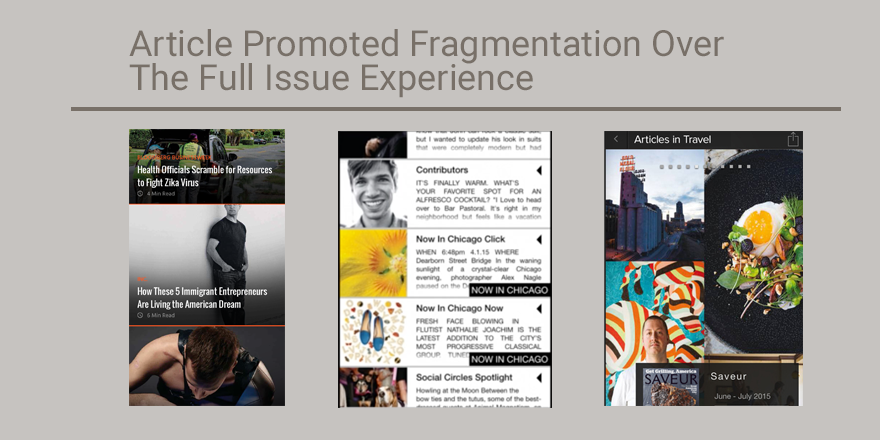
Some digital magazine platforms are choosing their delivery platform as the brandable front face for all the publisher’s readers being sent to read their publishers magazines. Yes, the digital publishing technology app has sold the publisher on separating just the most valuable aspects of the entire magazine “the feature articles” from the rest of the magazine. Wait a minute, that’s no longer a designed periodic compilation!
Definition: Magazine ~ for a digital future. A printing press is not required.https://t.co/8s5NhpvGX8 #in #publishing #magazines pic.twitter.com/cJVHW34jdS
— David Blankenship (@Davorado) October 9, 2016
If we extract the articles from the magazine in an effort to make them more readable, perhaps we should have started with readability in mind. But the real reason the articles are stripped from the issue is so the magazine app can offer an al la carte experience. Let us not forget how most publishers make money. But the frog was boiled because the publisher assumes the technology experts know how to get more eyeballs on the content. The business model morphs one small objective at a time where it seems like forward progress is occurring. I guess that’s why it’s important to have a digital publishing plan. And when the technology architecture of model no longer supports the goal it’s time to make a change. Publishers want to understand how publishing technology vendors are compensated so they don’t end up on a platform that never had the revenue to survive the business model that brought the publisher to the front door.
Vertical Magazine Publishing Solutions
HTML5 responsive magazine solutions are where we feel the industry is headed. Native web-based presentation can deliver an amazing experience across any device. For almost all the types of content presented today by magazine publishers including multimedia embeds, the responsive vertical edition offers instant issue presentation.
Custom design depicted in this video of VERTIQUL digital editions is priced higher than self-service tools like Issuu. The vertical magazine edition pricing includes ongoing issue custom graphic designer production. Branded domain and digital editions platform which include revenue generating capabilities beyond typical SAAS or in-house print-replica digital publishing software makes the platform a higher cost premium solution. And like other publisher solutions where consultants and industry experienced leaders are participating in the business, best practice strategy is provided to the publisher partners. Digital magazine strategies take advantage of the medium and expand both interactive advertising and longform content capabilities. The full production solution seeks to be more profitable for the publisher. But more importantly, is focused on UX for readers since they will return for the next issue if the experience is positive. As an alternative to other embedded digital magazine publishing software platforms for publishers, the format is obviously what we feel is a great option for publishers ready to move away from applications, newsstand, and app storefronts.
Advontemedia’s vertical edition solution is responsive HTML5 for any modern mobile device and produces a designed content flow that’s easy to ready and navigate. The business model is explicit to the magazine publisher and gives the publisher the branded domain for only their publication issues. No chance of sending audience to a magazine staged next to hundreds of other magazines or where the platform vendor uses banner ads around the issue to compensate for low-cost PDF to web conversion and hosting.
If we intend to foster a user experience where content is easily browsed, we need to move away from the portrait page-by-page horizontal flipping digital reading experience. By 2017, we will see many other magazine software applications and cloud publishing solution vendors taking advantage of the valuable editorial design communication outside traditional PDF and print-layout editions. Even if professional design services augment the plan, the platform should keep the reader user experience engaged and exclusive to the publisher’s magazine. Half of publisher audiences are now mobile and there’s never been a greater need for evolution in the interfaces for digital magazine publishing technology. We’ve begun to reach a plateau on the resolution for mobile devices and therefore technology developers can capitalize on mobile design principles. Indexed flow replaces pagination and interface architecture and theming can keep the visual UX experience impressive while also empowering the user to control their progression and depth engagement.
The disruptive magazine experience technology we predict that is upcoming in the next 10 years will be virtual reality interfaces and interactive AI artificial intelligence layered into the media engagement platform. This will include subscriber community live collaboration during the content consumption experience. Multiple content formats will converge through multiple senses during the user’s media reception. Visual, audio, and even tactile feedback via device or wearables will create new opportunities for publishers that artfully coalesce experiences with audiences. Vertical and 3 dimensional vs. Horizontal content control makes sense for this transition because we don’t want our users to become dizzy or disoriented. Eyes moving up and down or having content flow vertically down past a focal point is less dizzying for longer series of content at a fast pace than side-to-side. You’re only used to wipers moving side to side because Elon Musk hasn’t invented a vertical wiper or removed all together this disruption to our human sensory. And we will certainly be doing more magazine reading when we are riding around in self-driving cars. Under 5 years before autonomous vehicles are a reality and imagine the implications as digital integration unites multiple industries. Everything about our brands will be digital and as magazine publishers, we’re not going to wait out the transformation like newspapers publishing managers. I pitched, watched and listed to newspaper executives say “I’m not ready” to innovation because they were waiting for the Internet to come of age.
Immersive virtual and interactive content experiences are structured upon a storyline or theme. I submit that publishers will accept my modern definition of a magazine leaving the ink and paper for the novelty collectors and history books (which people will read digitally):
“A periodic compilation of sequenced relative materials and edited content published in a designed format.”
In summary, the digital magazine publishing process is quickly evolving to the mobile UX already in place for readers. It’s clear that the top tier newsstand publications need to be present as magazine apps for a native Apple or Google Play store while that’s still a materials segment or opportunity to reach this audience. But the majority of small to mid-tier publishing groups can benefit from responsively designed editions that display perfectly on any device our readers are using now. Before choosing a digital editions software partner or contracting with a digital publishing platform solution, test the experience exactly as your audience member. This includes using several devices and getting focus group feedback from your top subscribers to confirm they like the alternative to flip style or PDF presentations. Launching a new method of viewing the edition will be something you promote on social media and your best audience members should rally a positive technology upgrade and your decision to innovate.


